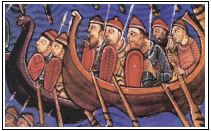Pastland | 930 A.D.-
1030 A.D.

 Modern
day Icelanders often point to the first Norse settlers as their
ancestors, often speaking
fondly of their colorful Viking past. Much of it
is writen down in the Landnamabok (Book of Settlements), one of
the early sagas.
While there is some argument as to the motives of
the first widespread Nordic settlement, convention holds that the
Norsemen were fleeing the tyranny of the Norwegian King Harald
Haarfagri, who drove them from their ancestral
lands in southern Norway. Arriving in Iceland, they threw high
seats over the edges of their longboats and built their new homesteads
where the seats washed ashore, believing
that the divine hand of Thor would choose the spot. Sometimes it
would take years before the seats were found. Modern
day Icelanders often point to the first Norse settlers as their
ancestors, often speaking
fondly of their colorful Viking past. Much of it
is writen down in the Landnamabok (Book of Settlements), one of
the early sagas.
While there is some argument as to the motives of
the first widespread Nordic settlement, convention holds that the
Norsemen were fleeing the tyranny of the Norwegian King Harald
Haarfagri, who drove them from their ancestral
lands in southern Norway. Arriving in Iceland, they threw high
seats over the edges of their longboats and built their new homesteads
where the seats washed ashore, believing
that the divine hand of Thor would choose the spot. Sometimes it
would take years before the seats were found.
The exiled Norse quickly developed
their own sense of national identity, creating in 930 what
is regarded as the world’s first parliamentary system, The
Althing. Local chieftans gathered at Thingvellir, a
natural amphitheater, where they elected leaders yearly. To prevent leaders from abusing
power, The Althing had no military to enforce its will, a stipulation that would later
cause problems when regional chiefs decided to take matters into their own hands. But
for the most part, these early years following the development of
the Althing were peaceful. It was an era of optimism, even for Erik the Red, who arrived after he
was banished from Norway for murder. When he committed the same crime in Iceland and was
exiled from there, too, he managed to convince 25 ships to follow him in a colonial
expedition to Greenland. His son, Iceland born Leif Eiriksson,
later sailed further west, becoming the first European to reach North
America, which he called Vinland. But
for the most part, these early years following the development of
the Althing were peaceful. It was an era of optimism, even for Erik the Red, who arrived after he
was banished from Norway for murder. When he committed the same crime in Iceland and was
exiled from there, too, he managed to convince 25 ships to follow him in a colonial
expedition to Greenland. His son, Iceland born Leif Eiriksson,
later sailed further west, becoming the first European to reach North
America, which he called Vinland.
 Viking Oasis
- Europe's Hard Shadow - Independence
Viking Oasis
- Europe's Hard Shadow - Independence |